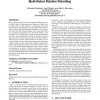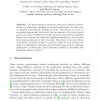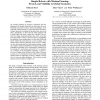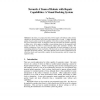124
Voted
ATAL
2008
Springer
15 years 2 months ago
2008
Springer
There is growing interest in multi-robot frequency-based patrolling, in which a team of robots optimizes its frequency of point visits, for every point in a target work area. In p...
ANTSW
2008
Springer
15 years 2 months ago
2008
Springer
Self-assembling multi-robot systems can, in theory, overcome the physical limitations of individual robots by connecting to each other to form particular physical structures (morph...
77
Voted
ANTSW
2008
Springer
15 years 2 months ago
2008
Springer
The improvement of odometry systems in collective robotics remains an important challenge for several applications. In this work, we propose a localisation strategy in which robots...
114
Voted
AAAI
2007
15 years 2 months ago
2007
Coordinating a group of robots to work in formation has been suggested for a number of tasks, such as urban searchand-rescue, traffic control, and harvesting solar energy. Algorit...
100
click to vote
AAAI
2007
15 years 2 months ago
2007
We consider problems of geometric exploration and selfdeployment for simple robots that can only sense the combinatorial (non-metric) features of their surroundings. Even with suc...
92
Voted
AAAI
2008
15 years 2 months ago
2008
We consider the problem of grasping novel objects in cluttered environments. If a full 3-d model of the scene were available, one could use the model to estimate the stability and...
101
Voted
ISER
2000
Springer
15 years 4 months ago
2000
Springer
: This paper discusses the general concept of the Super Mechano-System, or SMS and its anticipated applications. The SMS is a new type of robot system, which can transform its shap...
93
Voted
ISER
2000
Springer
15 years 4 months ago
2000
Springer
: In the future, we propose that there will be largely self-sufficient robot colonies operating on distant planets and in harsh environments here on earth. A highly desirable quali...
78
Voted
ECAI
2006
Springer
15 years 4 months ago
2006
Springer
We consider groups of autonomous robots in which robots can help each other by offering information-producing functionalities. A functional configuration is a way to allocate and c...
99
Voted
ANTSW
2006
Springer
15 years 4 months ago
2006
Springer
We present an algorithm for covering continuous domains by primitive robots whose only ability is to mark visited places with pheromone and to sense the level of the pheromone in t...




